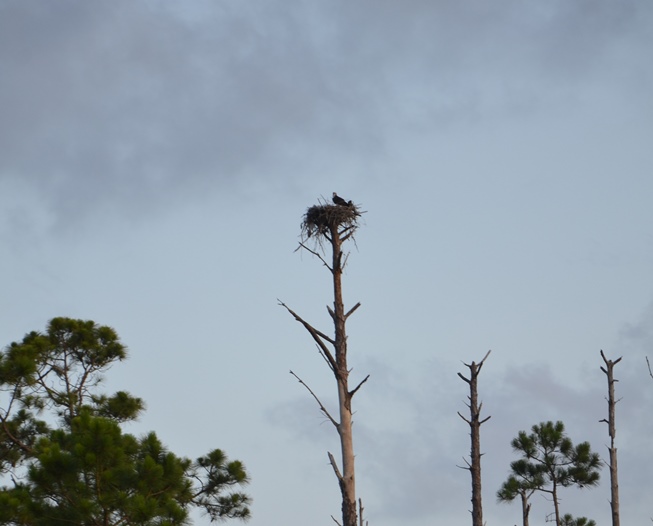
by Les Harrison
In north Florida water sports are a supreme pastime in summer. Fishing is among the most popular activity for all ages in this recreational realm.
Human anglers are not the only competitors seeking to land a trophy specimen. Ospreys, the local avian apex fisher, are literally plucking the fish from every river and body of water in the region.
Pandion haliaetus carolinensis is one of four osprey species worldwide and is native to north Florida. Geologic records in the area indicate a long residency and the possibility of extinct members of this genus who once lived in prehistoric Florida.
This aquatic predator is easily identified because of its size and nesting habits. Large specimens can have a six foot wingspan and their big nest are usually located in the tops of trees near a body of water.
The backs and wing tops of this bird are dark brown, but its underside is a snowy white. The head is white with a dark band over the eyes which gives the appearance of a mask.
Males and females are very challenging to distinguish individually as there are only small variations in their size and feather coloration. Side by side it is easier to see the difference in wing shape and body size.
As the several common names imply, the osprey’s diet is comprised of fish almost exclusively. Salt water catfish, mullet, spotted trout, shad, crappie and sunfish are some of the prey which stray into this bird’s sight when they swim too close to the water’s surface.
Osprey’s have the ability to hover in a nearly stationary position 100 feet or more above the water as they wait for their prey to move into the ideal position. When the fish is most vulnerable this bird drops almost vertically and securely clutches the fish in its talons.
Ospreys and owls are the only raptors, birds of prey, whose outer toes are reversible and which provide a highly effective gripping ability. A slippery fish is much less likely to escape when grasped by two talon-tipped toes on each side of the foot.
Their nest are large structures constructed of sticks. Ospreys commonly mate for life and will reuse nest for many years.
Utility poles, channel markers and other manmade locations with plenty of ground clearance and good visibility can be used by ospreys for nesting. Electrical power lines have proven problematic in a few cases if the birds contact the charged line and a grounding source.
Ospreys can be observed all year in Wakulla County and north Florida, especially near water bodies and shorelines. It is a safe bet they will leave with a good catch
To learn more about ospreys in north Florida contact your local UF/IFAS Extension.
 0
0
